Probably everyone has thought about starting their own online business at least once. But how can you do this with minimal costs? At this point, so many questions come up that an online business often remains just an idea. However, we can tell you how to do this with minimal costs and losses.
eBay is a perfect choice to start a dropshipping business. Why? It’s one of the most visited online marketplaces, with more than a billion monthly visitors, giving you the opportunity to reach a large audience. Interested? Let’s figure out what dropshipping on eBay is, how to start such a business, and what you need to be prepared for.
Key takeaways
- eBay dropshipping allows you to start your business with minimal upfront investment, as there is no need to purchase inventory.
- Focus on lightweight, popular products with good profit margins to reduce shipping costs and improve profitability.
- eBay’s fee structure includes store subscription fees, insertion fees, final value fees, and promotional fees.
Contents:
2. Preparing for the dropshipping process
3. How to start dropshipping on eBay?
- Create an eBay seller account
- Select products to sell
- Choose dropshipping suppliers
- List your products on eBay
- Set the price for the product
5. What are eBay seller fees for dropshipping businesses?
- Electronics
- Clothes and accessories
- Home and garden products
- Sports and fitness equipment
- Pet supplies
What is eBay dropshipping?
First and foremost, what’s dropshipping? Dropshipping is a retail fulfillment method where the seller lists products for sale without holding any goods at the warehouse. Instead, when a sale is made, the seller purchases the product from a third-party supplier who ships it directly to the customer. This means the seller never actually handles the product.
Dropshipping on eBay follows the same process, but the transactions take place on the eBay platform. Successful dropshipping depends on how well prepared you are. Let’s break down the eBay dropshipping process below.
Preparing for the dropshipping process
As with any business, you need to prepare before jumping into the game. If you have chosen eBay as your trading platform, study the terms and conditions that the site imposes on its seller — it’s a must. Below are the most important ones:
1. Stick to eBay when choosing suppliers
This can be confusing for newbies. You should purchase items from a wholesale supplier that’s set up to dropship, rather than from other marketplaces such as Amazon or Walmart. If you use these sites to purchase and ship products to your customers, eBay may remove your product and even suspend your account.
2. Provide on-time delivery
eBay requires that products be delivered within 30 days of payment. As a dropshipper, it’s your responsibility to make sure the products arrive on time, even though you’re not the one shipping them. This can be difficult if your supplier is overseas and uses slow shipping methods. Late deliveries can lead to penalties on your eBay account.
3. Account for eBay fees
Selling on eBay isn’t free. You need to factor eBay fees into your costs. For instance, If you list more than 250 items per month, there’s a $0.35 fee per listing. eBay also takes 13.25% of the final sale plus 30 cents per order. Make sure your prices cover these fees and still leave you a profit.
How to start dropshipping on eBay?
Now that you know every detail and are prepared, it’s time to start. Carefully follow each step to create your shop and capture the attention of eBay’s 135 million users. Let’s break down the eBay dropshipping process below.
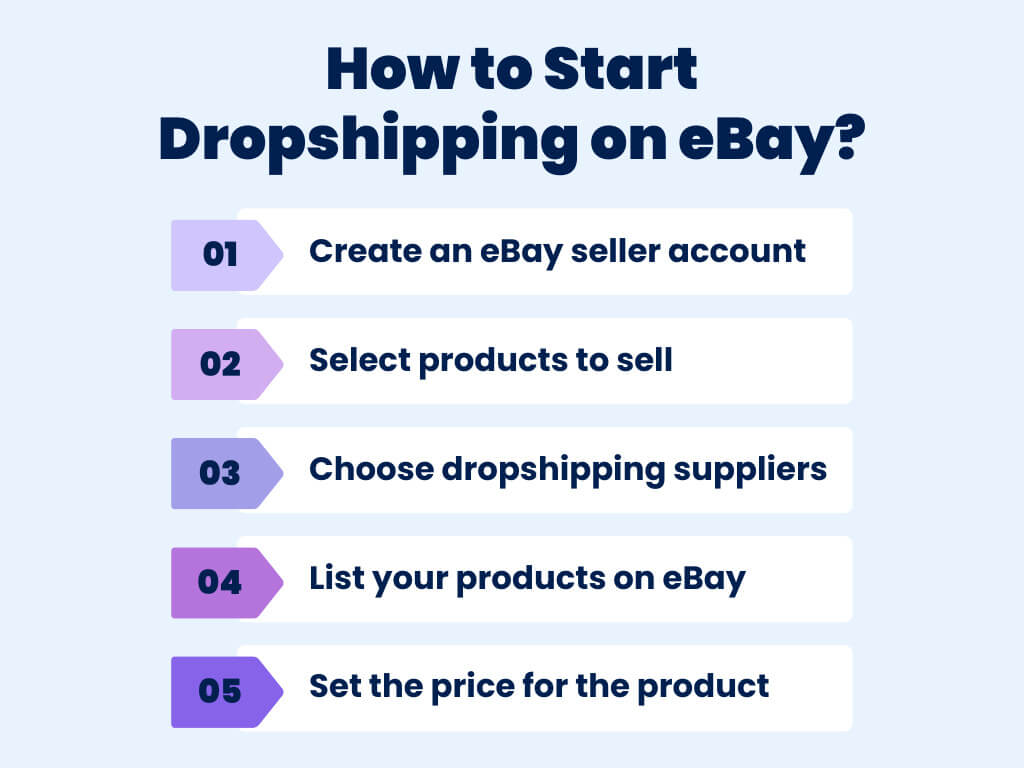
1. Create an eBay seller account
To start selling on eBay, first set up your eBay store account. Follow the steps on the site to complete the registration, including linking a checking account to receive payments.
2. Select products to sell
If you want to succeed, you need to carefully analyze and choose the best products to sell. How? You can use Google Trends or the eBay product research tool to see if a product’s search volume is increasing, which means it could sell. Check eBay’s bestsellers page to find popular products. Be careful with heavy items like furniture because high shipping costs can cut into your profits. Focus on lightweight, popular products with good profit margins. Some of the good options will be phone accessories, fitness gear, kitchen gadgets, pet supplies, fashion accessories.
3. Choose dropshipping suppliers
Research potential wholesalers by checking their reputation and customer reviews. Your wholesaler should provide a good user experience and fast shipping, as you’re responsible for ensuring customer satisfaction. To start, you can try to find your suppliers through online directories and marketplaces, referrals, search engines, trade shows and exhibitions, and social media.
4. List your products on eBay
Create a listing for each product with a detailed description and high-quality images. Use keywords in the description to improve search results on Google and eBay. Include customer reviews, if possible, to build trust. Make sure your return policy matches your wholesaler’s policy, as they will handle returns.
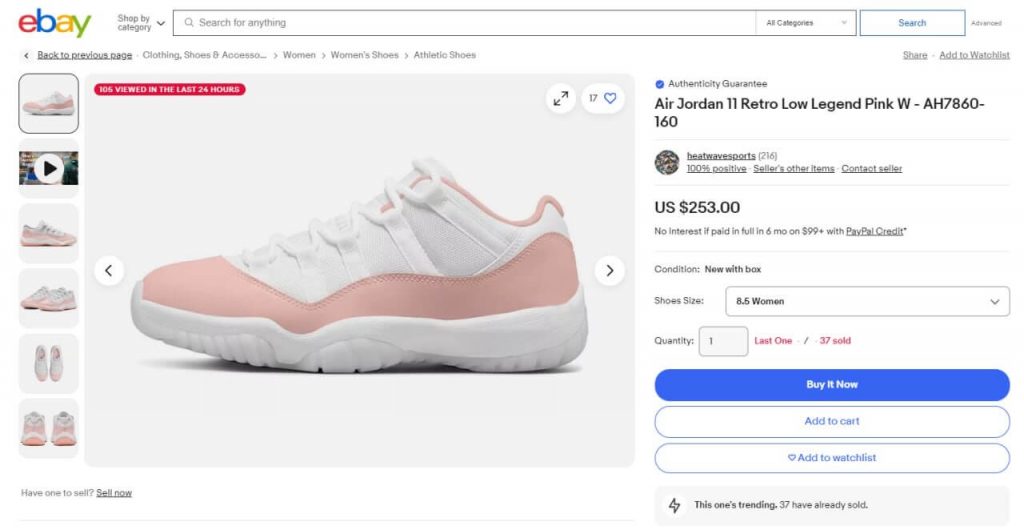
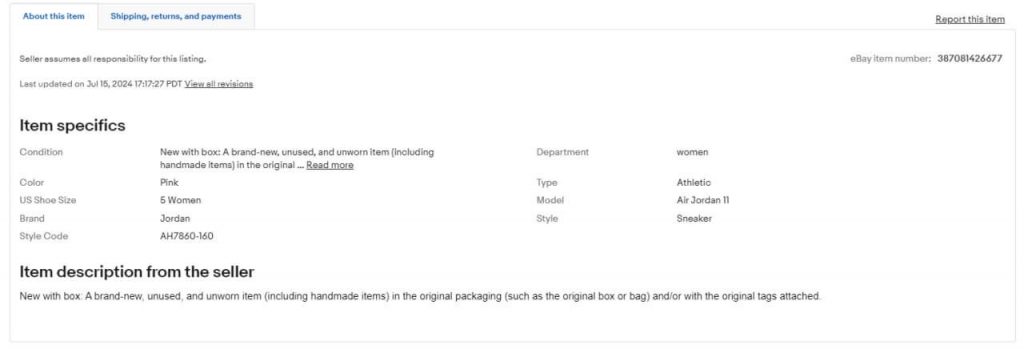
5. Set the price for the product
Set the price for your product by deciding your desired profit margin. You might mark up items by 10% or add a fixed amount, like $7. As we mentioned above, remember to include eBay’s fees in your pricing. These fees apply to the entire transaction, so make sure you still stay in the black.
Scaling your eBay business
If you want to scale your business, it is very important to stay on top of all sales processes. And Synder is exactly what you need for this. It’s a financial management software that automatically syncs detailed transaction data into your books. It works with over 30 different platforms, including marketplaces, payment gateways, and some POS systems.
Synder offers eBay integrations for the following accounting software:
- QuickBooks Online;
- QuickBooks Desktop;
- Xero;
- Sage Intacct.
We support your business growth by charging based on the number of transaction syncs, not the number of connected platforms. This means you can connect as many platforms as you want at no extra cost, ensuring an effective solution tailored to your needs.
One of the most important things is that Synder allows you to easily track eBay seller fees. As we learnt earlier, it’s a really important part of workflow, as is discounts, shipping, and eBay sales tax data. All of these aspects can be tracked by Synder Insights. You can get instant data on key ecommerce metrics like top products, platform fees, profit margins, cost of goods sold, and more. This helps you track how your business is doing overall and on each platform.
Among other features, Synder offers options that sellers might find useful not only during tax season but throughout the year:
- Multi-channel reconciliation;
- COGS tracking;
- Inventory tracking;
- P&L and balance sheet reports;
- Multicurrency management.
Withheld tax recording
Imagine you sold phone cases on eBay. The transactions you receive from payment platforms include taxes that need to be recorded in the books, even if you don’t keep the tax amounts or remit them to tax agencies. Synder handles this by recording the tax amounts in both the income and expense parts of a transaction. This effectively cancels them out.
Here’s how it works:

In your books, you’ll see:
- An Invoice/Sales receipt showing the total amount, including tax;
- An Expense entry showing the fee paid to the payment processor and the tax amount, indicating your business no longer owes the tax.
As you can see, Synder makes managing your finances easy. Once you set it up, it automatically organizes all your transactions into the right accounts, so you don’t have to do anything. It’s fully automated, accurate, and even provides pre-matched reconciliation.
To learn more about how simple and effective managing your business with Synder can be, use our 15-day free trialor join the Weekly Public Demo.
What are eBay seller fees for dropshipping businesses?
There are several types of eBay seller fees to remember when dropshipping:
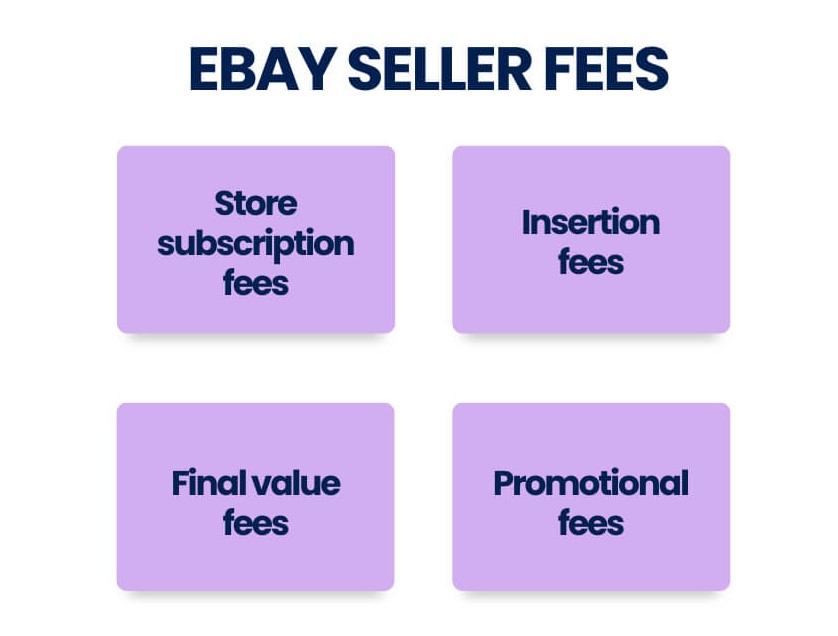
Each of them can influence your income, so let’s take a closer look at those fees and figure out how much money you’ll need to cover them.
Store subscription fees
These are the basic expenses required to get you started. Each seller can choose a subscription plan that suits them from five monthly or five annual options. These are the fees for each plan:
| Monthly renewal | |
| Starter store | $7.95 per month |
| Basic store | $27.95 per month |
| Premium store | $74.95 per month |
| Anchor store | $349.95 per month |
| Enterprise store | N/A |
| Annual renewal | |
| Starter store | $4.95 per month |
| Basic store | $21.95 per month |
| Premium store | $59.95 per month |
| Anchor store | $299.95 per month |
| Enterprise store | $2999.95 per month |
Insertion fees
Each store subscription plan includes a certain number of free listings. The higher your subscription level, the less you’ll pay for each additional listing. Let’s look at the detailed overview of insertion fees:
| Starter store | 250 fixed price listings + $0.30 per additional listing |
| Basic store | 1000 fixed price listings + $0.25 per additional listing |
| Premium store | 10,000 fixed price listings + $0.10 per additional listing |
| Anchor store | 25,000 fixed price listings + $0.05 per additional listing |
| Enterprise store | 100,000 fixed price listings + $0.05 per additional listing |
Final value fees
After insertion fees, you need to consider final value fees. These are the fees eBay charges for selling items on their platform. The fee is a percentage of the total sale amount (item price + postage and handling) plus a fixed charge of $0.30 per order.
The fee percentage depends on the product category and your store subscription. For example, if you have a Starter store and sell clothes, you pay:
- 8% per item if the sale amount is over $150;
- 12.9% per item if the sale amount is under $150.
For Basic, Premium, Anchor, and Enterprise store subscriptions, the fees are:
- 7% per item if the sale amount is over $150;
- 12% per item if the sale amount is under $150.
eBay calculates and automatically charges the final value fee at the end of a sale through eBay Managed Payments.
Promotional fees
Standing out when dropshipping on eBay is crucial. Besides the mandatory fees, you might incur promotional fees to market your products. Without a solid marketing strategy, it’s hard to reach the right audience and make sales.
eBay offers two promoted listing options: promoted listings standard and promoted listings advanced.
- Promoted listings standard: You pay eBay a set percentage only after a sale is made through their promotion.
- Promoted listings advanced: You pay a daily budget in advance to run ads, similar to pay-per-click (PPC) ads.
Top items to dropship
You can use Google Trends to check the search volume for the products you want to list on eBay. Higher search volumes show that people are actively searching and want to buy those products. Look for growing trends to find popular and growing products to include in your list. But you can start with these types of products:
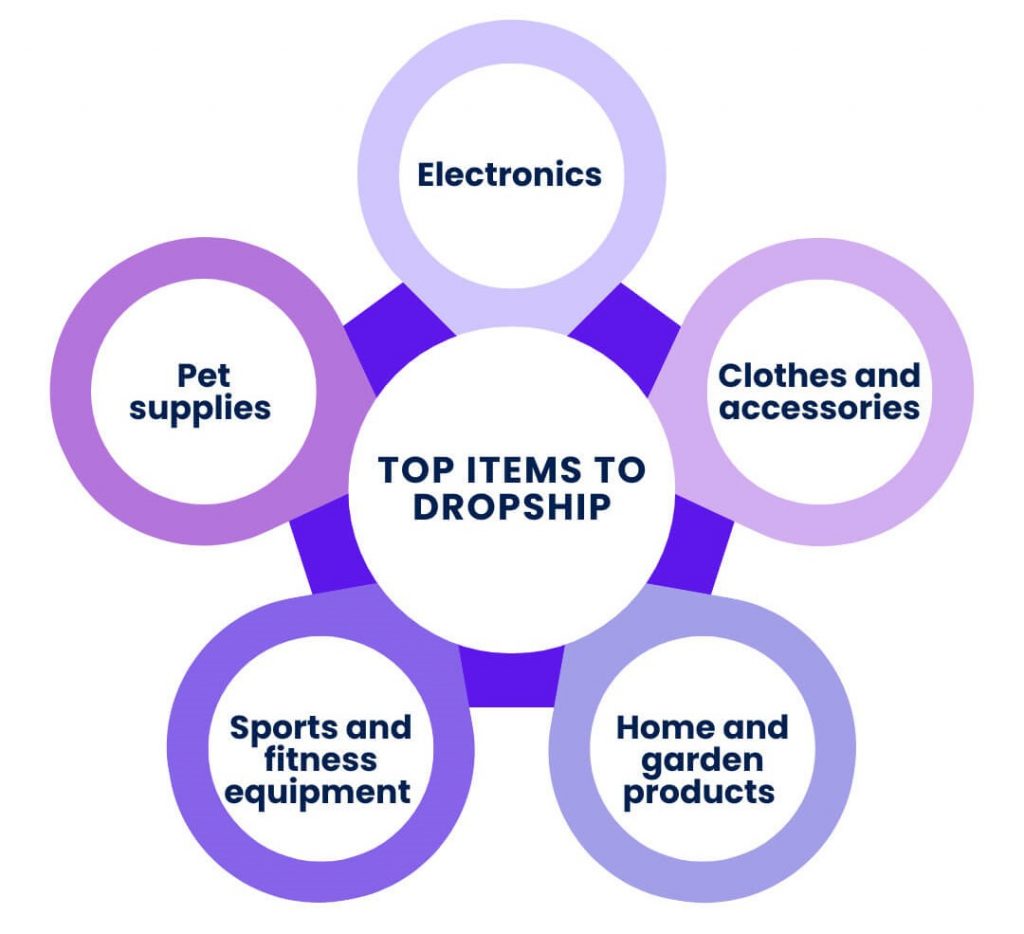
Electronics
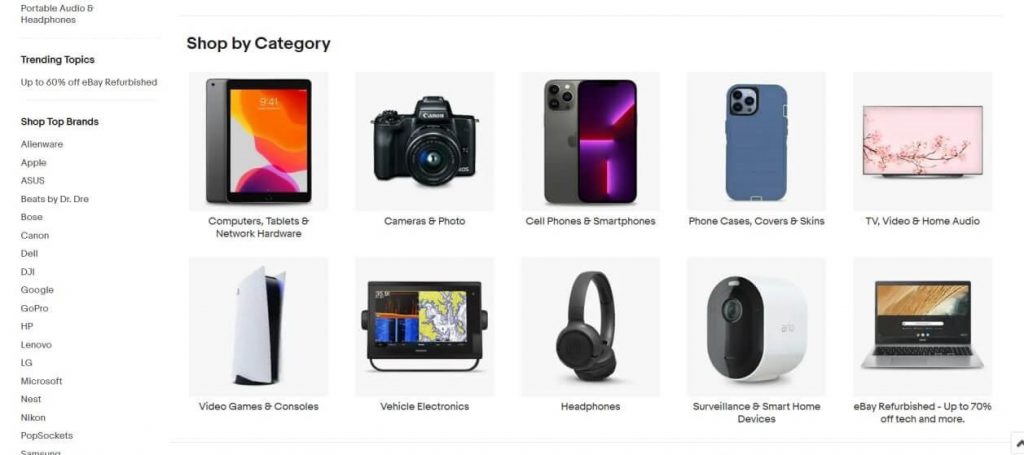
Electronics are among the top-selling products on eBay. This includes smartphones and accessories, tablets, laptops, gaming consoles, and other gadgets. Accessories for any type of electronics will be the best choice as it’s easy to find suppliers, and this type of product involves minimal risk. Everyone needs cases for their new phone, after all?
Clothes and accessories
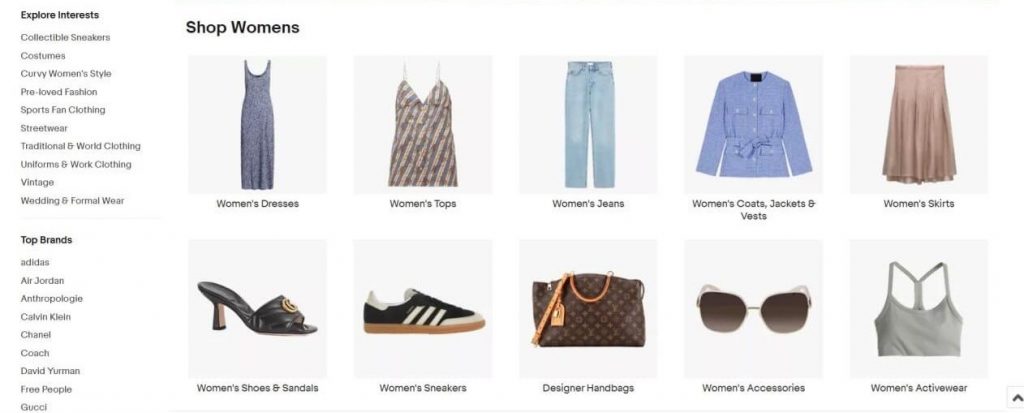
Clothing, shoes, and accessories are popular categories on eBay, making it a hotspot for fashion items. Whether for kids or adults, people are always looking for deals on clothing. The fashion industry on eBay is highly competitive, so staying up-to-date with the latest trends and offering unique products that stand out is your way to success.
FYI: Niches like vintage clothing or designer handbags can attract more customers.
Home and garden products
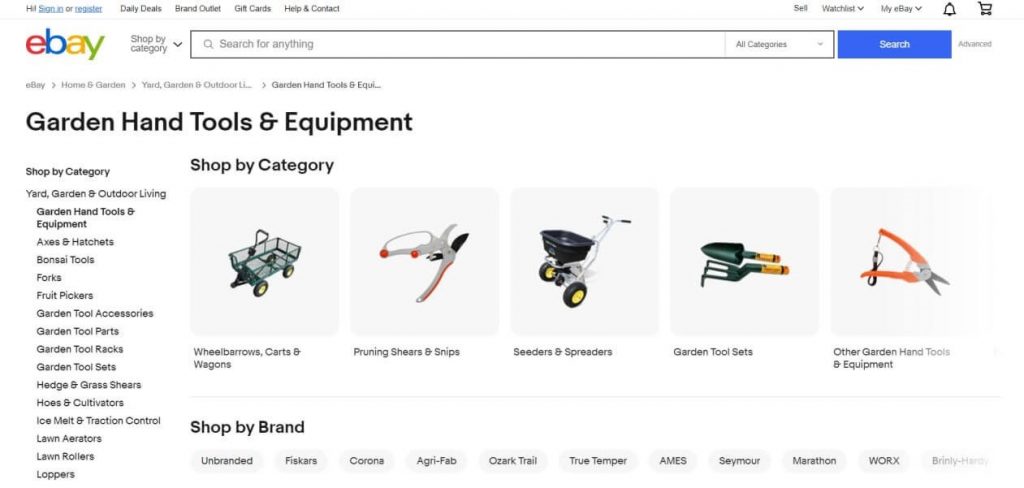
Home goods sell very well on eBay as people are always looking for products to decorate their home. Popular home products include kitchen utensils, pillows and slipcovers. Home and garden items such as furniture, decor, appliances and garden tools are also in high demand. As many people spend more time at home, there’s a growing need for products that enhance living spaces.
Sports and fitness equipment
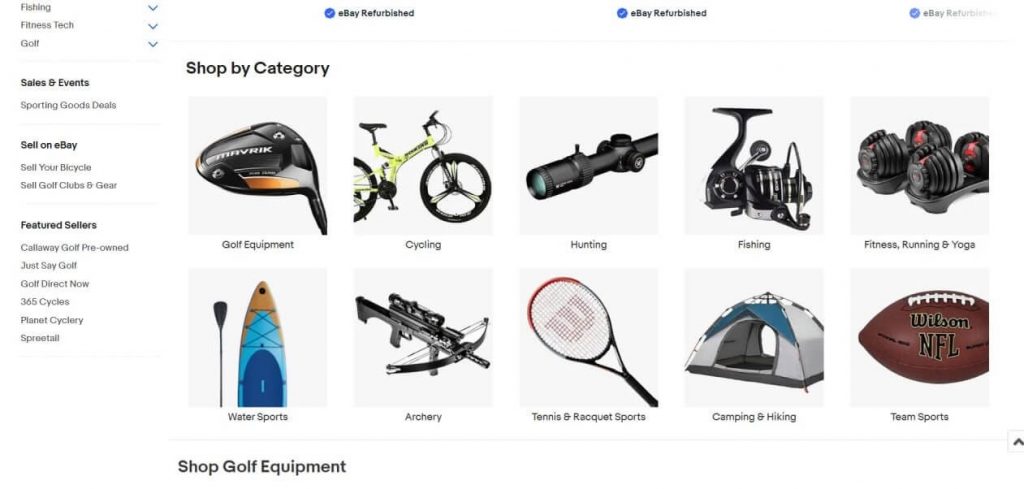
Sports and fitness equipment, including gym equipment, athletic apparel, and outdoor gear, are popular as people strive to maintain active lifestyles. Offering a variety of products for different sports and fitness activities can attract a wide range of customers.
Pet supplies
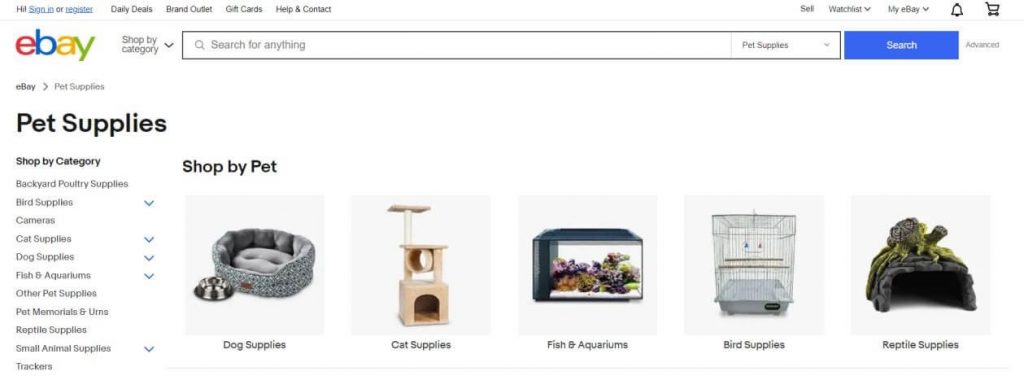
Many families have pets, making pet supplies a great dropshipping opportunity. This includes pet food, grooming supplies, toys and accessories. Offering organic or eco-friendly products can help you stand out in a competitive market.
Read more about best selling items on eBay in 2023.
Conclusion
Starting a dropshipping business on eBay is a great way to reach a large audience without needing a big initial investment. While it’s not the easiest path, if you understand eBay fees, choose the right products, and find reliable suppliers, you’ll build a strong foundation for your business. Focus on offering high-quality products, ensuring on-time deliveries, and creating attractive offers that set you apart from your competitors.
Share your thoughts
Tell us what you think! Have you tried dropshipping on eBay? What challenges have you faced, and how did you overcome them? Do you have tips for finding good suppliers or picking profitable products? Share your experiences, questions, and tips in the comments below.
FAQs
What are free listings on eBay?
eBay offers 250 free listings to start with, keeping initial investments low. If you need more listings, you can pay per listing or opt for a subscription. These 250 free listings are similar to having a Starter store. After using the free listings, eBay offers other subscriptions to fit your needs and goals.
Is eBay dropshipping worth it?
It depends. eBay dropshipping can be worth it due to its low upfront costs and access to a large customer base. On average, eBay dropshippers process 969 orders each month, earning about $2,587 in monthly profits. However, success depends on finding reliable suppliers and managing eBay’s fees and policies effectively.
How much does the average eBay dropshipper make?
The average profit margin for dropshipping on eBay ranges from 10% to 30%. A one-person dropshipping business typically has a 30% profit margin, but it can go as high as 60% if you source cheap products from reliable suppliers.
How to start dropshipping from eBay?
To start dropshipping on eBay, first create a seller account. Then, find profitable products, vet your dropshipping suppliers, and set competitive prices. Create detailed eBay listings, and once you receive orders, forward the information to your supplier for fulfillment.
What are the pros of dropshipping on eBay?
Dropshipping on eBay offers several advantages:
- Low initial investment: You don’t need to buy inventory upfront;
- Large customer base: You have access to millions of eBay users;
- Ease of setup: It’s simple to create a seller account and start listing products;
- Scalability: You can easily add more products without having to manage inventory;
- Reduced risk: No inventory means less financial risk if items don’t sell.
What are the cons of dropshipping on eBay?
- High competition: Many sellers offer similar products, so it’s hard to stand out;
- Low profit margins: With lots of competition, profits can be slim;
- Strict policies: eBay’s rules are strict, and breaking them can get your account suspended;
- Supplier reliability: Relying on third-party suppliers can lead to quality and shipping issues;
- Limited control: You have little control over inventory and fulfillment processes.


.png)
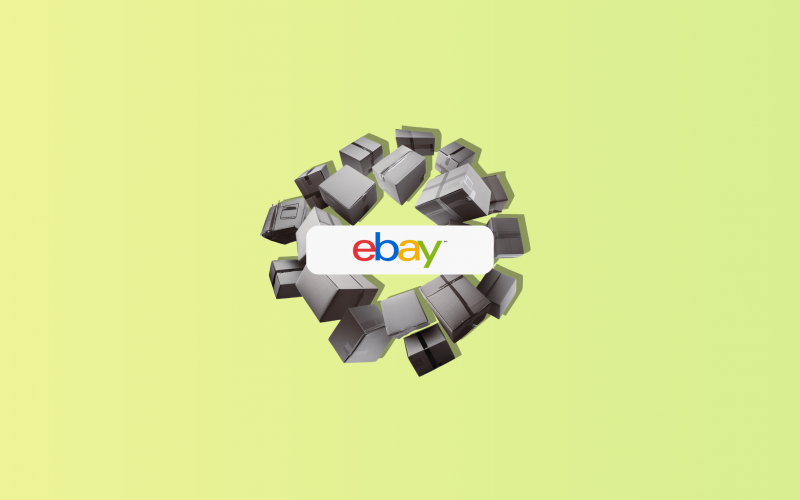
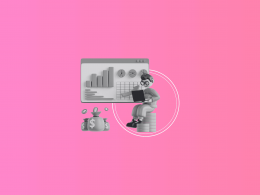



Thanks for the article! This Ebay dropshipping guide will be helpful for the management of my personal tax advisory UK business.
Thank you, David! We’re glad we could help!